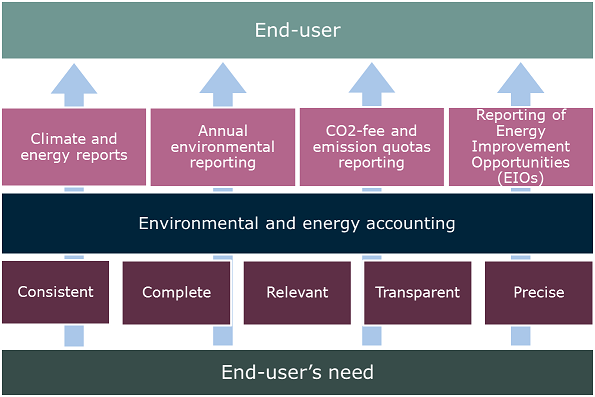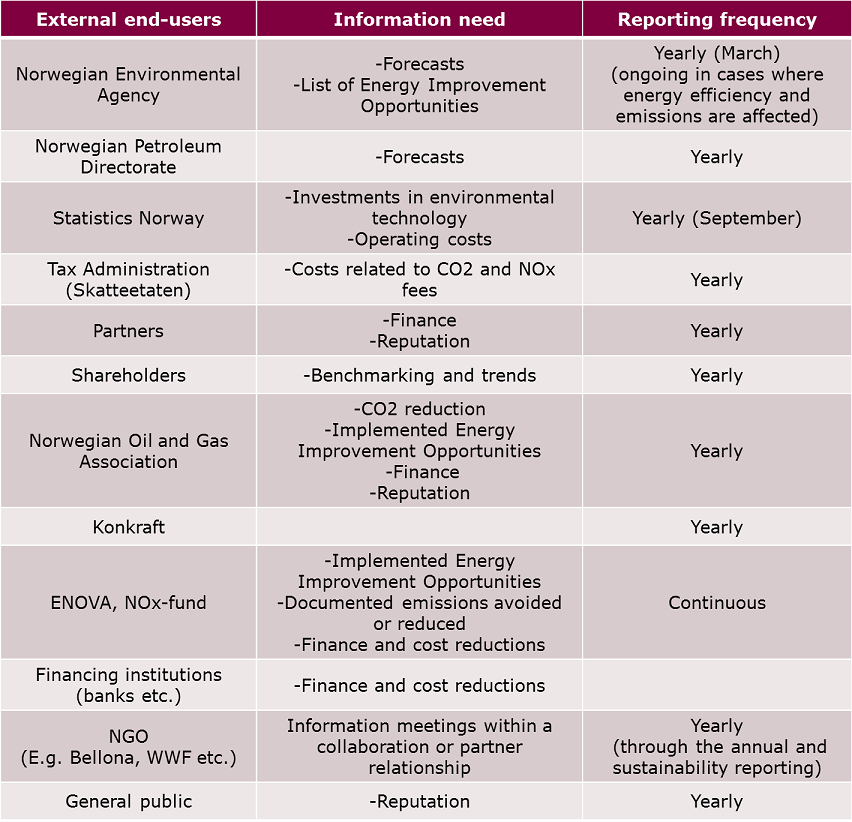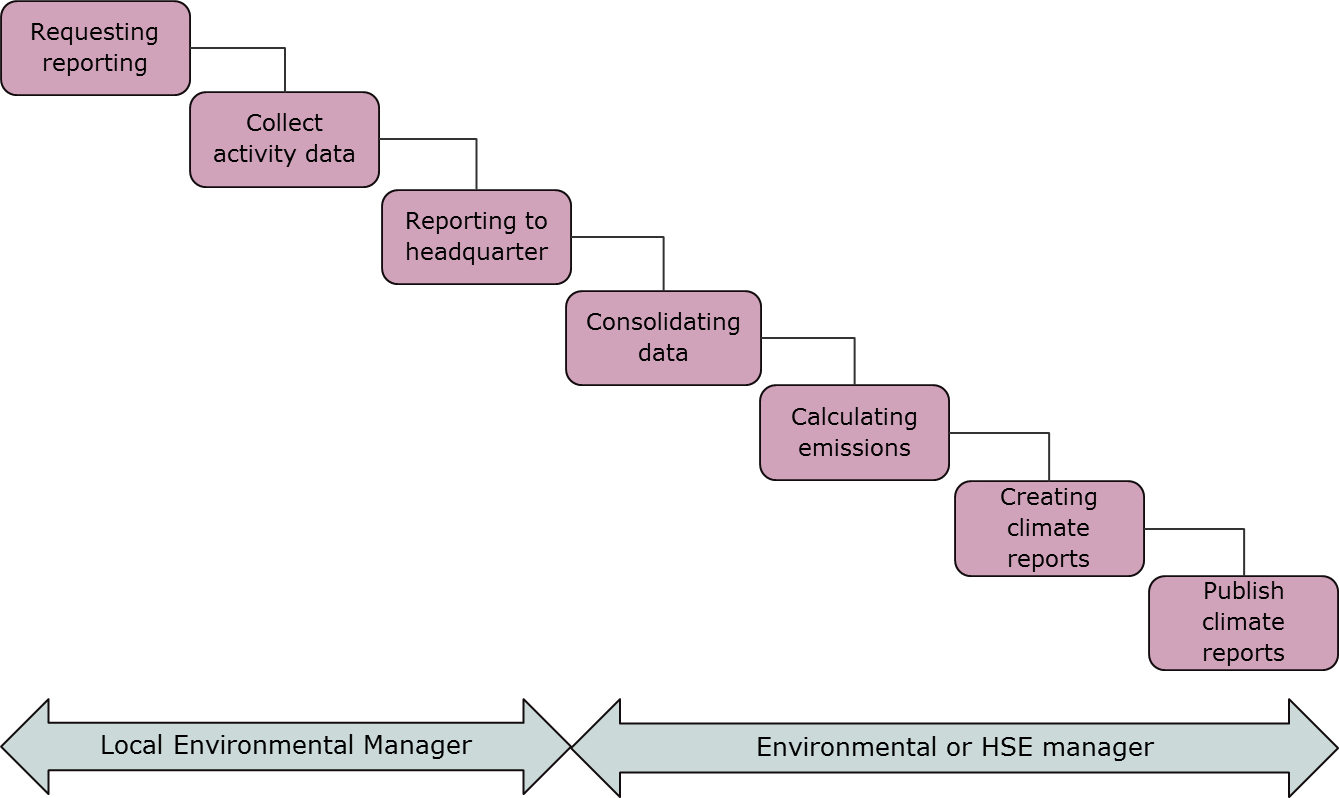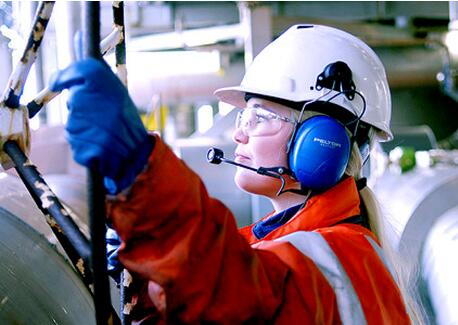Energy management and energy efficiency take place at different organisational levels. This requires preparing reporting procedures to avoid double work, and to ensure consistency in what is reported.
![]() What should be done?
What should be done?
Reporting is often divided into public (what must be reported) and internal reporting. The former includes information and documentation required by law or through permits (e.g. Norwegian Environment Agency, Norwegian Petroleum Directorate). The second type is reporting according to internal requirements and routines, as well as other external expectations. Regardless of the type of reporting the approach should be the same so that the system becomes more efficient and that you avoid double work and ensures consistent data collection/reporting.
An appropriate and effective reporting process is based on the following elements:

These steps are described below.
1. Identification of end-user and their needs (define delivery)
An end-user can be described as: “Individual or organisation, identified by those reporting environmental / energy related information, as the one being dependent on this information to make decisions”.

Often, not enough time is used to identify the end-user and their needs. It is therefore a risk that wrong information is reported or that the level of the detail in the material is not adapted to the recipient’s needs. This may contribute to inefficient use of resources, it does not provide sufficient basis for decisions, etc. The possibility that reporting presents relevant and complete information is strengthened by following a standardised process as shown in the figure above.
A prescribed process is expected in environmental and quality systems in the 2015 version of ISO 9001 and ISO 14001, respectively. It is therefore recommended to integrate this mapping of end-users with the requirements of the other management systems.
| How can I identify end-users (also referred to as stakeholder) and their needs? |
|---|
|
Make a list of relevant end-users, what decisions they must make and their need for information. End-users can be individuals, roles or organisations, for example: Internal:
Authorities:
Other external:
|
The table below provides examples of information needs for the individual end-users.
| Examples of internal end-users, their information needs and reporting frequency |
|---|
|
As a basic rule, the internal end-users have a need for information about:
Other potential relevant information is: 
|
The table below provides examples of information needs for individual end-users.
| Examples of external end-users, their information needs and reporting frequency |
|---|
|
External end-users can be categorised as follows:
As a basic rule, all have an information need for:
Other potential relevant information is: 
|
2. Establishing a reporting and communication plan
The following information should be included in a reporting and communication plan:
- Who are the end-users
- What must be reported (depending on the reporting requirements, e.g. GRI, GHG Protocol)
- How will the reporting be carried out (via intra- and / or internet, report format etc.)
- Who shall report
- When will it be reported (frequency)
Reporting of energy management is closely linked to climate reporting. Therefore, a similar process can be built up within energy reporting and be a part of a reporting plan. A typical process for climate reporting consists of the following steps:

Further information can be found on the page about Internal and external communication.
3. Determination of internal routines and collection of information and data
This step includes partly determination of internal recording and reporting routines and partly collection of information and data.
Establishing effective internal procedures for recording and reporting/aggregation is often identified as a challenge. This can be improved by identifying which roles are affected, having clear descriptions/procedures as well as through internal training.
Collection of data and information are done from different parts of an installation/field and your own organisation. The information is processed and compiled into a custom reporting format. It is standard practice that the results are presented to the end-user before final delivery.

Collection of information and data are needed for among others:
- Follow-up of authority requirements and expectations related to energy management, energy efficiency and greenhouse gas emissions
- Follow-up of KPIs
- Follow-up of energy targets
4. Quality assurance, internal or third party
For certain types of reporting there is a need for an external third party check or verification, while internal verification is sufficient for other types of reporting. Regardless of reporting format, it is important to have procedures for quality assurance and verification as an integral part of the reporting process. For example, it is important that the individuals/roles that have provided input to the reporting get a possibility to verify their own input. An example of a framework for quality assurance is shown in the figure below.

With increased transparency, it is important that the various reporting formats are based on a common platform for the purpose of collecting data as well as how calculations are preformed (e.g. for emissions).
It is important to take into account the following principles of quality assurance:
- Consistent; consistent reporting over time and document any changes.
- Complete; the information reported shall be completely within the defined scope.
- Relevant; the information reported shall reflect the end-users’ need for information.
- Open; all relevant issues to be reported in a factual and coherent way and inform about relevant assumptions, references to applied methodology and calculations.
- Accurate; sufficient accuracy should be achieved and reducing uncertainties as far as practicable within acceptable cost.
5. Distribution/publication of delivery/report
Distribution and publication of results/reports are done via various internal and external platforms, such as:
- Annual reporting from the offshore petroleum activities for the Norwegian Environment Agency (your company’s central reporting channel)
- Environmental Hub (EEH), see details below
- Altinn, where among others emission reports are reported in accordance with the emission permit
Det mest sentrale er at informasjonen kommer frem til rett sluttbruker og innenfor forventet tid, noe som gjelder både internt og eksternt.
![]() Who should be involved?
Who should be involved?
Different companies have different levels and areas of responsibilities when it comes to reporting. This often includes:
- Process/operations team for each installation/field
- Energy team
- Economy function/responsible
- HSE team and role that is responsible for reporting on climate
- HSE team at corporate level and roles that are responsible for reporting total emissions (often associated with sustainability reporting)
![]() What should be documented?
What should be documented?
The following documentation is recommended within reporting:
- Reports/documentation according to reporting and communication plans
- Documentation of quality assurance
Reporting should be anchored in other reporting systems, management systems and reporting standards such as annual reporting, ISO 14001, EMAS (Eco Management and Audit Scheme), GRI, CDP. Different parts of the organisation may be responsible for collecting energy data and it is therefore also important that this is coordinated internally.
| Examples of relevant reporting systems/standards/guidelines |
|---|
|
![]() Challenges and solutions
Challenges and solutions
What could be future reporting requirements?
There is an increased focus in the industry to be more open (transparent) and this can, among others, be done through increased internal and external reporting. In Norway today (2016) there is an expectation of increased and more effective reporting including, among others:
- More reporting of lists of improvement opportunities (EIOs), updating and maintenance of implemented measures
- Expected and future EIOs (reporting to the NEA)
- Further development of Environment Hub (EEH) to include energy management and EIOs
- Increased focus on corporate level to report sustainability and reduction in energy consumption and greenhouse gas emissions
- Increased demand from investors on how the company manages and takes responsibility for the climate change challenge in the world, and energy and climate data.
What is the definition of a measure or EIO?
It is important to clarify what defines an energy measure and what should be reported accordingly. Below is a general basic rule to identify energy measures.
| Identification of energy measures |
|---|
|
As a basic rule, an EIO is related to energy efficiency if the answer to one of the following questions is yes:
|
![]() Where do you find this in ISO 50001?
Where do you find this in ISO 50001?
Chapter 4.5.4 – Documentation

